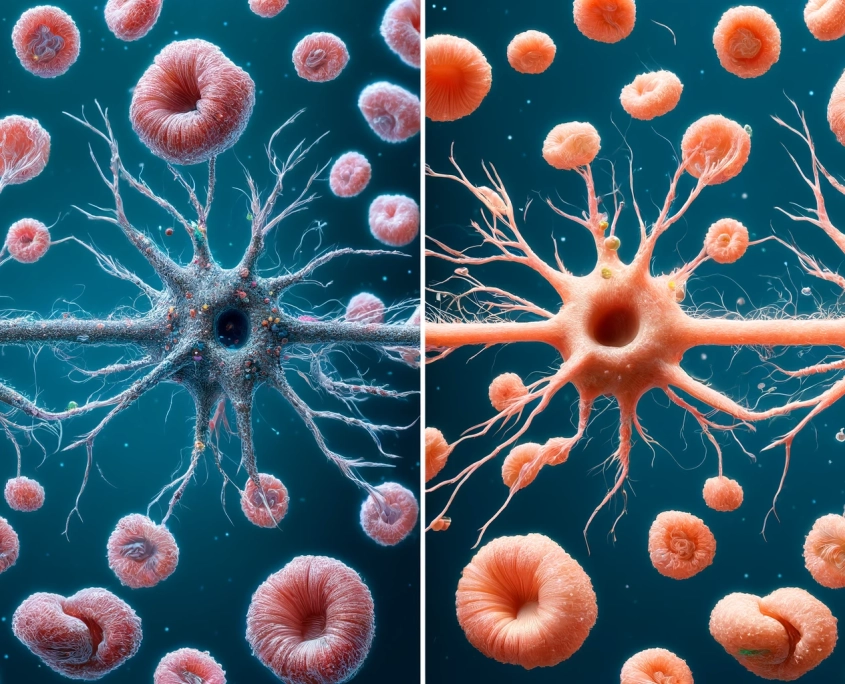The Role of Glycation in Human Health: Mechanisms, Implications, and Interventions

Glycation, a non-enzymatic reaction between sugars and proteins, lipids, or nucleic acids, leads to the formation of advanced glycation end-products (AGEs). This process, occurring endogenously and exogenously, plays a significant role in aging and the pathogenesis of various chronic diseases.
Introduction
Glycation is a critical biochemical process impacting human health, particularly in the context of aging and chronic diseases. It involves the covalent bonding of sugar molecules to proteins, lipids, or nucleic acids without enzymatic regulation, resulting in the formation of AGEs. This paper aims to explore the underlying mechanisms of glycation, its health implications, and potential interventions to mitigate its adverse effects.
Mechanisms of Glycation
Glycation is initiated by the reaction between a carbonyl group of reducing sugars (such as glucose or fructose) and the amino groups of proteins, lipids, or nucleic acids. This process occurs in several stages:
- Early Glycation (Schiff Base Formation and Amadori Product Formation):
- The initial reaction forms a Schiff base, which undergoes rearrangement to produce a more stable Amadori product. For example, glucose reacts with the amino group of a protein to form fructosamine.
- Intermediate Glycation:
- The Amadori products undergo further complex reactions, leading to the formation of reactive intermediates such as dicarbonyl compounds.
- Advanced Glycation (AGE Formation):
- The reactive intermediates eventually lead to the formation of AGEs, which are diverse and structurally complex molecules.
Endogenous and Exogenous
Endogenous Glycation
Endogenous glycation occurs naturally within the body and is accelerated under conditions of hyperglycemia, as seen in diabetes mellitus. AGEs can alter protein function and contribute to various pathophysiological conditions, including:
- Collagen cross-linking: Leading to reduced elasticity in tissues such as skin, blood vessels, and joints.
- Glycated hemoglobin (HbA1c): Used as a marker for long-term glucose control in diabetic patients.
- Cellular dysfunction: Affecting cellular receptors and enzymes, contributing to inflammation and oxidative stress.
Exogenous Glycation
Exogenous glycation results from the ingestion of dietary AGEs. Foods high in sugars and those cooked at high temperatures, such as fried, grilled, or roasted foods, have high AGE content. These dietary AGEs contribute to the body’s overall AGE burden.
Health Implications of Glycation
The accumulation of AGEs in tissues and organs is associated with numerous health complications, including:
- Diabetes-related complications: AGEs contribute to the development of diabetic neuropathy, nephropathy, and retinopathy.
- Cardiovascular diseases: Glycation of vascular proteins leads to arterial stiffness and atherosclerosis.
- Neurodegenerative diseases: AGEs are implicated in the pathogenesis of Alzheimer’s disease and other neurodegenerative conditions.
- Aging: AGEs contribute to the aging process by promoting tissue stiffness and increasing oxidative stress.
Prevention and Management of Glycation
Various strategies can be employed to prevent and manage glycation and its adverse effects:
- Dietary Modifications:
- Reducing the intake of high-sugar foods and foods cooked at high temperatures can lower dietary AGE intake.
- Emphasizing the consumption of fresh, whole foods and cooking methods that produce fewer AGEs, such as steaming or boiling.
- Blood Sugar Control:
- Maintaining normal blood glucose levels through diet, exercise, and medication is crucial for minimizing endogenous glycation.
- Antioxidant Supplementation:
- Antioxidants such as vitamins C and E can counteract the oxidative stress induced by AGEs.
- AGE Inhibitors:
- Compounds like aminoguanidine have shown potential in inhibiting AGE formation, although their clinical use is still under investigation.
- Lifestyle Modifications:
- Regular physical activity, smoking cessation, and maintaining a healthy weight can help reduce AGE accumulation.
Conclusion
Glycation is a significant biochemical process with profound implications for human health, particularly in the context of chronic diseases and aging. Understanding the mechanisms of glycation, its health impacts, and potential interventions is crucial for developing strategies to mitigate its adverse effects. Through dietary modifications, blood sugar control, antioxidant supplementation, and lifestyle changes, the burden of AGEs can be reduced, promoting better health and longevity.
References
- Brownlee, M. (1995). Advanced protein glycosylation in diabetes and aging. Annual Review of Medicine, 46(1), 223-234.
- Vlassara, H., & Uribarri, J. (2014). Advanced glycation end products (AGE) and diabetes: cause, effect, or both? Current Diabetes Reports, 14(1), 453.
- Ramasamy, R., Yan, S. F., & Schmidt, A. M. (2005). The AGE-RAGE axis and diabetic complications. Current Diabetes Reports, 5(3), 232-238.
- Singh, R., Barden, A., Mori, T., & Beilin, L. (2001). Advanced glycation end-products: a review. Diabetologia, 44(2), 129-146.
- Uribarri, J., Woodruff, S., Goodman, S., Cai, W., Chen, X., Pyzik, R., … & Vlassara, H. (2010). Advanced glycation end products in foods and a practical guide to their reduction in the diet. Journal of the American Dietetic Association, 110(6), 911-916.
- Baynes, J. W. (2001). The role of AGEs in aging: causation or correlation. Experimental Gerontology, 36(9), 1527-1537.
- Genuth, S., Sun, W., Cleary, P., Sell, D. R., Dahms, W., Malone, J., & Monnier, V. M. (2005). Glycation and carboxymethyllysine levels in the DCCT/EDIC cohort: associations with kidney disease and retinopathy. Diabetes, 54(11), 3274-3281.
- Stitt, A. W. (2010). The role of advanced glycation in the pathogenesis of diabetic retinopathy. Experimental and Molecular Pathology, 84(1), 75-80.
- Peppa, M., Uribarri, J., & Vlassara, H. (2003). The role of advanced glycation end products in the development of atherosclerosis. Current Diabetes Reports, 3(4), 293-298.
- Ott, C., Jacobs, K., Haucke, E., Navarrete Santos, A., Grune, T., & Simm, A. (2014). Role of advanced glycation end products in cellular signaling. Redox Biology, 2, 411-429.
